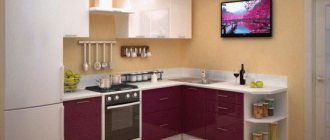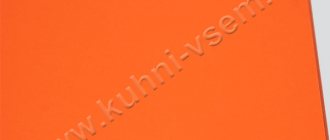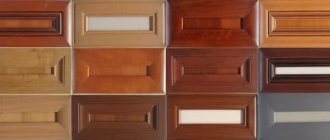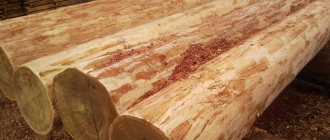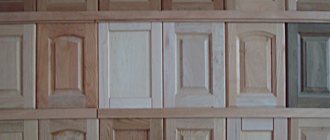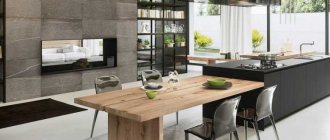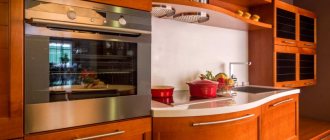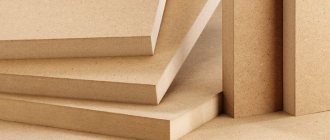Solid wood
Wood is the most famous, and previously uncontested, natural material. Wood can be called a traditional material for making kitchen facades: the first kitchens were made only of wood. To increase the service life of wood facades, the surface is treated with special septic tanks and varnishes.
Solid wood facades can be solid or paneled. Solid facades are made only from wood, have greater weight and price when compared with paneling. Internally paneled facades are made of MDF or chipboard, and the façade frame is made of solid wood.
| Advantages: | Flaws: |
|
|
- 1 of 4
On the picture:
MDF painted
Painted facades are MDF boards coated with several layers of furniture enamel and finally varnish. Painted MDF allows you to get rich and bright colors. Spectacular gloss will add a special chic to your kitchen. Enamel allows you to create glossy, matte, pearlescent and metallic effect surfaces. The technology for painting MDF occurs in stages: the surface of the MDF is covered with an insulator, after which primer is applied, then painted and varnished. To achieve a deep glossy surface, the layers are sanded and polished.
| Advantages: | Flaws: |
|
|
- 1 of 2
On the picture:
MDF film
Film MDF is made by applying PVC film to an MDF board. PVC film protects the MDF surface from deformation and moisture. This film is resistant to light and is easily cleaned from contamination. It can be glossy, matte, with a pattern, or differ in texture. PVC film in appearance can be an imitation of natural materials, for example, the cut surface of wood, marble, granite
| Advantages: | Flaws: |
|
|
- 1 of 2
On the picture:
Pros and cons of acrylic
So, which is better, acrylic or plastic?
Acrylic is one of the newfangled materials, the demand for which is growing every day. This is a durable coating, 1 mm thick, with a glossy texture. Other advantages of an acrylic kitchen are as follows:
- The material retains its performance properties even after many years of service.
- Easy to care for. To remove dirt from the acrylic surface, simply use a soft cloth soaked in warm, soapy water.
- Possibility of restoring smoothness and shine by polishing. Even if scratches appear on the acrylic surface, they can be removed by polishing.
- Acrylic kitchens are highly resistant to high humidity.
- Environmentally friendly and completely safe for health.
However, this material also has some disadvantages. The disadvantages of an acrylic kitchen are not so numerous. For example, curved facades or facades decorated with decorative milling cannot be created from acrylic. And because of the gloss, on which any dirt is clearly visible, you will have to do additional cleaning to remove greasy stains and droplets (after almost every cooking).
MDF covered with plastic
The ends of the facade can be processed in three ways: 1. Cladding with aluminum profiles. 2. Cladding four sides of the facade with acrylic or PVC. 3. Postforming - plastic is bent at two ends of the facade, the remaining two ends are lined with PVC or acrylic edges.
MDF is used as the basis of the facade, which is lined with plastic. Modern plastic has an attractive appearance and visually allows it to imitate natural materials, for example, wood, stone, metal. The advantage of MDF facades lined with plastic is their high strength and resistance to high temperatures, moisture and ultraviolet radiation. The surface can be cleaned by almost any means, and to scratch the plastic, you need to make an effort. Plastic facades can be either glossy or matte.
| Advantages: | Flaws: |
| Flaws:
|
- 1 of 3
On the picture:
Pros and cons of plastic
Plastic kitchens are a more familiar option for modern people. A set with plastic facades will cost less than acrylic. Such material will be more resistant to temperature changes, and the variety of color palettes can surprise even the most spoiled customer.
However, this type of material requires more careful and complex care (especially with a matte texture), and the decorative pattern can be deformed due to the peculiarities of the application technology.
As you can see, it is impossible to unequivocally answer the question of what is better for the kitchen: acrylic or plastic. In this case, each buyer will have to make their own choice, taking into account the advantages and disadvantages of each material. In many ways, the answer to the question of which kitchen is better than plastic or acrylic will depend on the taste preferences and financial capabilities of the buyer.
Source: huga.by
KITCHEN CATALOG
KITCHENS BY SHAPE
PROMOTION!
Measurement Delivery Installation
3d design project
FOR FREE
KITCHENS IN STYLE
KITCHEN COLORS
PARTNERS
MDF covered with natural veneer
Natural veneer facades are visually as close as possible to expensive facades made of valuable wood, but they cost less, so they are highly popular among buyers in the expensive segment. Veneer is a cut of valuable wood, which is used to cover the MDF board, which is the basis of the facade. Special technologies and chemical compositions make it possible to give MDF veneer facades high strength, as well as increased moisture resistance. Veneer facades are often used in classic interiors.
| Advantages: | Flaws: |
|
|
- 1 of 3
On the picture:
Choice of decorative and color designs
Purchasing a kitchen with MDF facades is an opportunity not only to choose the appropriate shade from several hundred possible options, but also to receive a coating with the already mentioned special effect in the following options:
- Chameleon. The facades are distinguished by shades that change depending on the viewing angle and the incidence of light.
- Patination or crackle. Surfaces with an aged effect are created, appropriate in a classic interior or Provence style.
- Mother-of-pearl or pearls. After painting, the facades are additionally coated with a composition that provides a color shift or a hazy shimmer.
- Metallic. The enamel is immediately mixed with special substances that give a metallic shine.
Metallic is beautiful not only on a car.
You can also use facades with a pattern that is applied to the surface over the enamel using a stencil manually. You can select the color of the image individually (monochrome or special effects are possible). After applying several layers of varnish on top, the facade is polished. The layout of the drawing can be drawn up by the customer.
Chipboard
The most affordable material is chipboard. Among its advantages, in addition to low price, is resistance to mechanical damage. In appearance, chipboard facades are inferior, for example, to MDF facades, and also allow a slightly lower level of humidity.
| Advantages: | Flaws: |
|
|
- 1 of 3
On the picture:
How to check the quality of a painted MDF kitchen facade
Painted MDF kitchen facades are expensive, so be sure to check the high quality of the products before purchasing.
To do this, you need to follow a few simple steps:
- carefully examine the facades from different angles - the glare should be even, waves and irregularities are unacceptable;
- there should be no smudges, paint or varnish on the surface. This is especially true for the edges of the product;
- try to leave a fingerprint on the facade - it can be easily wiped off with a soft cloth from a well-painted panel;
- take a closer look at the dust particles under the top layer - there should not be too many of them.
Plastic
Modern plastic production technologies make it possible to reproduce surfaces that are as close in appearance as possible to natural materials, such as wood or stone. The base of the facade is MDF or chipboard, and plastic is applied to the surface of the boards and determines the visual perception that makes plastic facades so popular.
| Advantages: | Flaws: |
|
|
- 1 of 3
On the picture:
Materials for making kitchen furniture
The main materials from which kitchen furniture is made are wood of various species, MDF and chipboard. Each of these options has its own advantages and disadvantages.
Tree
Wooden kitchen facades have always occupied a leading position among all materials for furniture manufacturing. Their advantages are difficult to exaggerate, because... This raw material has proven itself over many years of operation. With proper processing and thorough drying, kitchen facades will not bend or crack. Wood very easily takes the desired shape, so carpenters are happy to use it to make carved facades with the most intricate figures. A huge advantage is that wooden products can be easily updated with painted facades. A kitchen made from this material is durable and always modern. One hundred percent argument in favor of a wooden kitchen set is that this material is environmentally friendly. This factor not only does not harm health, but also strengthens it. It has been proven that when interacting with wood, an additional surge of strength and energy appears, which is so necessary for everyone in the era of chemical substitutes for natural materials. The only drawback of a wooden set is its considerable cost.
Natural wood facades can be restored independently
MDF
This material is a wonderful invention of our time. It is based on wood dust, compressed under the influence of hot air. Such raw materials are very durable and easy to process, giving kitchen products intricate shapes. A kitchen with MDF furniture is multifunctional and durable. It is not afraid of temperature changes and high humidity, is easy to wash, does not crack, and the corners and edges of facades do not break off. The fastening mechanisms hold securely for many years of use, because The monolithic plate firmly holds the fastening screws and bolts. Such furniture can be easily restored, given the desired shade to painted facades, and inlaid with moldings and carved patterns. Painted kitchen facades will perfectly update the interior, make it bright and stylish, and also allow its owner to demonstrate his creative skills in the original design of the kitchen. The only controversial drawback is the relatively high price and the ability of painted facades to fade under direct sunlight. Experienced craftsmen recommend not skimping and purchasing high-quality kitchen furniture that will last for decades, and lightened surfaces can always be updated with painted facades.
MDF panels can imitate absolutely any material
Chipboard
This material is made by gluing together pieces of shavings of different sizes. The plate turns out to be very brittle and does not bend under the influence of hot air, therefore it is not used for the production of complex models with facades decorated with carvings. The functional properties of chipboard are also very questionable. This material does not tolerate high humidity and temperature changes. The result is a disposable option that cannot be restored and a painted analogue is not able to update the kitchen. The only advantage of a chipboard kitchen set is its low price. But since the miser pays twice, experienced craftsmen recommend purchasing higher-quality material for the kitchen, so as not to update it every year and not spend effort creating a painted version.
Kitchen sets based on chipboard, in principle, cannot last long, but are still popular due to their low cost
Acrylic
The technology for making acrylic facades is quite new. To produce such a facade, an MDF board is used as a base, acrylic plastic is applied on the outside, and a white laminate is applied on the inside. This allows you to create stunning glossy surfaces. Acrylic facades attract the buyer at first glance with their depth of color and shiny surface. Acrylic facades are edged at the edges using an aluminum profile or an acrylic edge is used to match the color of the facade. An important fact of using acrylic is the ability to restore the surface of the facade in case of damage using conventional grinding.
| Advantages: | Flaws: |
|
|
CONS of acrylic kitchen facades
- Uniform surface without patterns or woody colors.
- A small palette of choice - 21 glossy and 7 matte colors.
- Resistance to increased scratches is lower than that of equivalently priced HPL plastic.
- SUPER GLOSSY. Judging by the reviews of owners of acrylic kitchens, some consider the perfect gloss to be a plus, while others consider the dazzling shine of its solar reflections to be a minus. If you don't want to give up acrylic beauty. We recommend complementing the interior with curtains or roller blinds, or... Order furniture made from super-matte nano-plastic FENIX NTM.
It is not a shortcoming, but a feature of acrylic that our company abandoned the production of glass facades (showcases).
Using the trial method, we realized that high-quality processing of the inner side of the ends with an edge is impossible. And the use of chrome beads on expensive acrylic material reduces the cost of the set as a whole.
Summarizing the pros and cons of an acrylic kitchen
The pros of an acrylic kitchen outweigh the cons. But this is our opinion. Let us remind you that practicality and functionality, external beauty and stunning characteristics can fill your home with a new style. And the disadvantages of a limited range of colors should not prevent this!
Glass
A kitchen set finished with mirror glass can be an unexpected and very effective solution. Cleaning up won't be easy. But the bulky box will literally disappear into the surrounding space.
In the photo: Salon kitchen from Nolte Kuechen.
Glass facades are usually made of tempered glass or triplex glass. At the same time, if the triplex breaks, it does not fall into fragments, but remains within the frame of the facade. Glass can be either transparent or frosted, colored, decorated with decorative patterns, sandblasted images, matting paste or film. Glass is a translucent material; this property allows you to add hidden lighting to the kitchen interior, which can be placed directly in the cabinets. As a rule, the ends of glass facades are edged with an aluminum profile frame, which protects the ends from chipping and also gives the kitchen an aesthetic appearance.
| Advantages: | Flaws: |
|
|
- 1 of 2
On the picture:
Features of caring for painted kitchen facades
In the photo of kitchen sets that are actively used, you can see how noticeable fingerprints and drops of grease are on glossy, pearlescent and metallic-colored facades. Caring for such surfaces requires attention and accuracy, because some coatings are afraid of abrasives. These do not include patina and a number of varnishes. But if you're painting your kitchen yourself, you'll likely be using readily available materials that tend to break down when using detergents containing solids. Surfaces resistant to such substances can only be manufactured in factory conditions.
Painting of facades? the optimal solution for both updating the kitchen and ordering new furniture. The higher cost of such solutions is fully justified by the operational and aesthetic properties of the finished products.
Metal
Metal facades are usually made of stainless steel or aluminum. Wooden facades are inferior in strength to metal facades. When designing a high-tech kitchen interior, designers often give preference to metal facades, although in the chalet style you can also find combinations of sparkling steel surfaces and aged wood. Aluminum facades are lighter than stainless steel facades. Aluminum withstands temperature fluctuations, is durable and resistant to high humidity.
| Advantages: | Flaws: |
|
|
- 1 of 1
Necessary tools for painting
Before making repairs, you need to think through and prepare in advance all the tools and equipment that will be needed when performing repainting work. Experts also recommend making a sketch or some sketch of the project you are aiming for. This will help avoid problems both before and after the repair begins. The drawing will help with the following:
- calculate the material;
- create a visual representation of the final look;
- see and correct shortcomings;
- choose a color scheme.
If it’s difficult for you to decide on a sketch on your own, then you can always consult with your loved ones or trust a specialist.
Tools are an important component. You will need:
- machine for grinding work;
- coloring composition;
- priming;
- sandpaper;
- brush;
- paint container;
- rollers;
- masking tape;
- spray gun;
- screwdriver;
- film (on the floor);
- Screwdriver Set;
- construction hair dryer;
- gloves.
If desired, some things can be excluded. If you are sure that only a brush is enough for the job, then rollers or sprayers are not purchased.
In the case where additional decoration is planned, other items may be useful:
- stencils;
- decorative elements (wooden blanks, crystals, etc.);
- glisal.
The list can be expanded. It depends on the wishes for the appearance of the headset. For some, simply updating the color is enough, while others will want to make changes to the stylistic design of the furniture.
